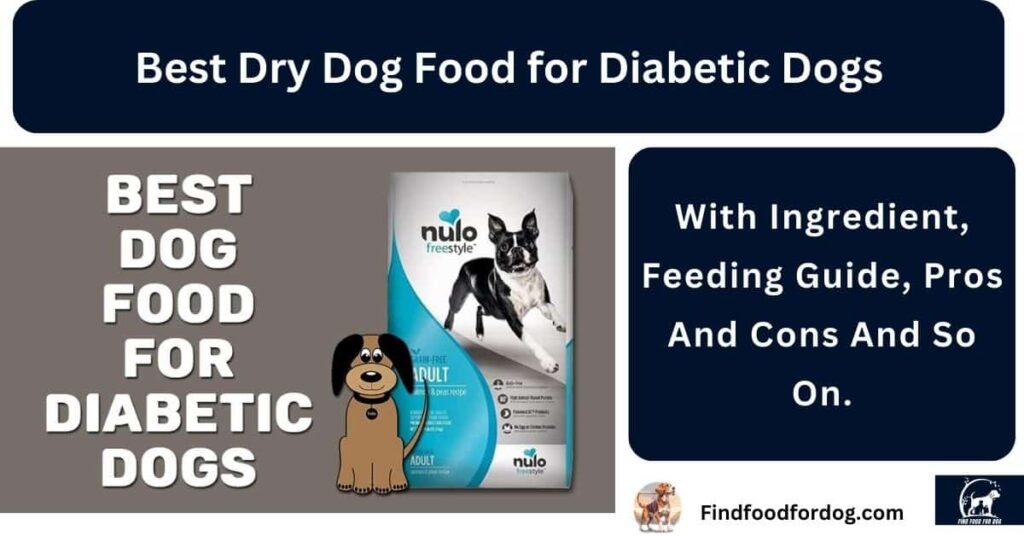The best dry dog food for diabetic dogs includes options like Hill's Prescription Diet Metabolic and Royal Canin Glycobalance. These formulas focus on low carbohydrates and high fiber to help manage blood sugar levels.
Finding the right dry dog food for diabetic dogs is crucial for their health. Diabetic dogs require special dietary considerations to maintain stable glucose levels. High-fiber, low-carbohydrate foods can help manage their condition effectively. Brands like Hill's and Royal Canin offer specialized formulas designed for diabetes management.
Always consult your veterinarian before making dietary changes. They can recommend the best options tailored to your dog’s specific needs. A proper diet not only aids in blood sugar control but also supports overall well-being. Prioritize quality ingredients to ensure your furry friend remains healthy and active.
The Importance Of Diet In Managing Canine Diabetes
A proper diet is crucial for diabetic dogs. Nutrition plays a key role in regulating blood sugar levels. Choosing the right food helps manage symptoms and improve overall health. Understanding dietary needs can lead to a happier, healthier pet.
Identifying Symptoms Of Diabetes In Dogs
Recognizing diabetes symptoms in your dog is essential. Early detection can lead to better management. Here are some common signs:
- Increased thirst (polydipsia)
- Frequent urination (polyuria)
- Increased appetite (polyphagia)
- Weight loss despite eating well
- Lethargy or decreased energy levels
Consult your veterinarian if you notice these symptoms. Early intervention can prevent complications.
Role Of Nutrition In Diabetes Management
Nutrition significantly affects diabetic dogs. A balanced diet helps stabilize blood sugar. Here are key dietary components:
| Component | Benefits |
|---|---|
| High fiber | Slows sugar absorption |
| Low glycemic index | Reduces blood sugar spikes |
| Quality protein | Supports muscle maintenance |
| Healthy fats | Provides energy without raising blood sugar |
Choosing the right dog food is vital. Look for options specifically formulated for diabetic dogs. Consult your vet for personalized recommendations.
Monitor your dog's weight regularly. Adjust portions based on activity level and weight. A proper diet leads to better health and quality of life.

Royal Canin
Hill's Science Diet
Purina Pro Plan
Blue Buffalo
Key Nutritional Considerations For Diabetic Dogs
Choosing the right food is vital for diabetic dogs. Proper nutrition helps manage blood sugar levels. Focus on balanced ingredients to support their health.
Balancing Proteins, Fats, And Carbohydrates
Understanding the right balance of nutrients is crucial. Each component plays a specific role in your dog's diet.
| Nutrient | Importance | Sources |
|---|---|---|
| Proteins | Builds muscles and tissues | Chicken, Fish, Turkey |
| Fats | Provides energy and supports skin health | Fish oil, Flaxseed oil |
| Carbohydrates | Source of energy, but must be controlled | Sweet potatoes, Brown rice |
A balanced diet includes:
- High-quality proteins
- Healthy fats
- Limited carbohydrates
Monitor the carbohydrate intake. Too many carbs can spike blood sugar levels. Opt for foods with a higher protein and fat ratio.
The Significance Of Low Glycemic Index Foods
Low glycemic index (GI) foods release sugar slowly. This helps prevent sudden spikes in blood sugar.
Key benefits of low GI foods include:
- Stable energy levels
- Better weight management
- Improved overall health
Examples of low GI foods for dogs:
- Barley
- Chickpeas
- Green beans
Always choose dry dog food labeled as low GI. This ensures better control over your dog's diabetes.
Reviewing The Top Dry Dog Foods For Diabetic Dogs
Choosing the right food for diabetic dogs is crucial. The right diet helps control blood sugar levels. This guide reviews the best dry dog foods specifically for diabetic dogs.
Criteria For Selection
Selecting the best dry dog food requires careful consideration. Here are the key criteria:
- Low Glycemic Index: Foods that do not spike blood sugar.
- High Fiber Content: Fiber aids digestion and stabilizes glucose levels.
- Quality Protein Sources: Essential for muscle health and energy.
- Natural Ingredients: Avoid fillers, artificial flavors, and preservatives.
- Balanced Nutrients: A well-rounded diet supports overall health.
Expert Recommendations
Experts recommend several brands for diabetic dogs. Each option meets the necessary criteria.
| Brand | Key Features | Average Cost |
|---|---|---|
| Hill's Science Diet | Low glycemic ingredients, high fiber, vet-recommended | $60 for 30 lbs |
| Royal Canin Veterinary Diet | Specially formulated for diabetes, supports weight loss | $70 for 28 lbs |
| Purina Pro Plan Veterinary Diets | High protein, low carbs, balanced nutrients | $65 for 35 lbs |
| Blue Buffalo Life Protection | Whole grains, no artificial preservatives, natural ingredients | $55 for 30 lbs |
Royal Canin
Hill's Science Diet
Purina Pro Plan
Blue Buffalo
Each of these brands provides quality nutrition. They support diabetic dogs effectively. Choose one based on your dog's specific needs and preferences.

Royal Canin
Hill's Science Diet
Purina Pro Plan
Blue Buffalo
In-depth Look At Top Picks
Choosing the right dry dog food for diabetic dogs is crucial. These top picks cater to various needs. Each brand offers unique benefits and features. Explore the options below.
Brand A: High-protein Formula
Brand A focuses on high protein content. This helps maintain muscle mass and energy levels. The formula contains:
- Real meat as the first ingredient
- Low carbohydrates to manage blood sugar
- Added fiber for digestive health
This brand is perfect for active dogs. The high protein keeps them strong. Check out the key features:
| Feature | Details |
|---|---|
| Protein Content | 30%+ |
| Carbohydrate Level | Low |
| Flavor Options | Chicken, Beef, Salmon |
Brand B: Grain-free Option
Brand B offers a grain-free option. This is ideal for dogs with sensitivities. Key benefits include:
- No corn, wheat, or soy
- High-quality proteins
- Fruits and vegetables for vitamins
This option supports healthy digestion. Dogs enjoy the taste. Here are the main points:
| Feature | Details |
|---|---|
| Grain-Free | Yes |
| Protein Source | Turkey, Fish, Lamb |
| Aging Support | Antioxidants included |
Brand C: Budget-friendly Choice
Brand C provides quality at a lower price. This is perfect for budget-conscious pet owners. Benefits include:
- Balanced nutrition for diabetic dogs
- Accessible ingredients
- Widely available in stores
This brand does not compromise on quality. Check its features:
| Feature | Details |
|---|---|
| Price Range | $40-$60 per bag |
| Protein Content | 20%+ |
| Flavor Options | Beef, Chicken |
Feeding Guidelines For Diabetic Dogs
Feeding diabetic dogs requires careful attention. Proper guidelines help manage their blood sugar levels. This ensures a healthier and happier life for your pet.
Determining The Right Portion Sizes
Portion sizes play a crucial role in managing diabetes. Follow these steps to determine the right amount:
- Consult your veterinarian for specific recommendations.
- Use a measuring cup for accuracy.
- Adjust portions based on your dog's weight and activity level.
For general reference, here is a table of portion sizes:
| Dog Weight (lbs) | Daily Caloric Intake (kcal) | Portion Size (cups) |
|---|---|---|
| 10 | 200 | 1.5 |
| 20 | 400 | 2.5 |
| 30 | 600 | 3.5 |
| 40 | 800 | 4.5 |
Monitor your dog's weight regularly. Adjust portions as needed. This helps maintain a healthy weight.
Frequency Of Feeding
Feeding frequency also affects blood sugar levels. Consistent timing is key. Follow these tips:
- Feed your dog twice a day, 12 hours apart.
- Provide meals before insulin injections.
- Keep a consistent schedule to stabilize blood sugar.
Some owners prefer to divide the daily portion into three meals. This can help with better sugar control. Monitor your dog’s response and consult your vet if needed.
Transitioning Your Dog To A Diabetic-friendly Diet
Switching your dog to a diabetic-friendly diet is crucial. This helps manage blood sugar levels. A careful transition ensures your dog adapts well. Follow the right steps for a smooth change.
Steps For A Smooth Transition
- Choose the Right Food: Select a high-quality, low-carb dog food.
- Gradual Introduction: Mix the new food with the old food.
- Increase Slowly: Gradually increase the new food each day.
- Monitor Portions: Keep an eye on portion sizes to avoid overeating.
- Stay Consistent: Feed at the same times every day.
Monitoring Your Dog's Response
Watch for any changes in your dog's behavior. Look for signs of discomfort or distress. Keep an eye on their energy levels and appetite.
Important indicators include:
- Weight changes: Is your dog gaining or losing weight?
- Water intake: Is your dog drinking more or less?
- Bathroom habits: Any changes in urination or stool?
Regular vet check-ups are essential. Discuss your dog's progress with your vet. Adjust the diet as needed based on their advice.
Additional Dietary Tips And Considerations
Managing diabetes in dogs requires careful attention to their diet. Choosing the right food is essential. Beyond selecting the best dry dog food, consider supplements, additives, and foods to avoid. This ensures a balanced approach to your diabetic dog's nutrition.
Supplements And Additives For Support
Supplements can help manage your diabetic dog's health. Here are some beneficial options:
- Omega-3 Fatty Acids: Support heart health and reduce inflammation.
- Fiber: Aids digestion and stabilizes blood sugar levels.
- Probiotics: Enhance gut health and boost the immune system.
Always consult your vet before adding any supplements. They can recommend the best options based on your dog's needs.
Foods To Avoid
Some foods can worsen diabetes in dogs. Avoid these items:
| Food Type | Reason to Avoid |
|---|---|
| High-Carbohydrate Foods | Can spike blood sugar levels. |
| Sugary Treats | Lead to quick insulin spikes. |
| Grains | Often high in carbs and sugars. |
| Processed Foods | Contain unhealthy additives and preservatives. |
Royal Canin
Hill's Science Diet
Purina Pro Plan
Blue Buffalo
Always read labels carefully. Understanding what goes into your dog's food is crucial. Healthy choices lead to better blood sugar control.
Success Stories: Real-life Impact Of Diet Change
Changing a dog's diet can lead to amazing transformations. Many dog owners have witnessed incredible results after switching to dry dog food designed for diabetic dogs. These success stories highlight the importance of proper nutrition. Here are two case studies that show the positive effects of diet changes.
Case Study 1: Overcoming Challenges
Meet Max, a seven-year-old Labrador. Max was diagnosed with diabetes. His owners struggled to manage his condition. Regular vet visits and insulin shots were costly and stressful.
After extensive research, they switched to a high-fiber, low-carbohydrate dry dog food. This food helped regulate Max's blood sugar levels. Within weeks, Max showed more energy and a happier demeanor.
- Before Diet Change: Frequent insulin shots
- After Diet Change: Reduced insulin dependency
- Weight Loss: 5 pounds in 3 months
Max's owners were relieved. They found a solution that improved his quality of life. Choosing the right food made all the difference.
Case Study 2: Noticeable Improvements
Next, we have Bella, a five-year-old Beagle. Bella was overweight and lethargic. Her owner felt helpless watching her struggle. Bella’s vet recommended a specialized dry dog food for diabetes.
After changing her diet, Bella’s transformation was remarkable:
| Time Frame | Weight Loss | Energy Level | Overall Health |
|---|---|---|---|
| 1 Month | 3 Pounds | Increased | Improved |
| 3 Months | 8 Pounds | Very Active | Excellent |
Bella now enjoys daily walks and plays with other dogs. Her owner feels joyful seeing her active and healthy. Proper nutrition turned Bella’s life around.

Merrick
Frequently Asked Questions
What Is The Best Dry Dog Food For Diabetic Dogs?
The best dry dog food for diabetic dogs is low in carbohydrates and high in protein. Look for brands that use quality ingredients. Foods with high fiber content can help regulate blood sugar levels. Always consult your veterinarian for specific dietary recommendations tailored to your dog's needs.
How Does Dry Food Help Diabetic Dogs?
Dry dog food formulated for diabetes typically contains controlled ingredients. These foods help stabilize blood sugar levels and promote healthy weight management. They often feature high fiber and low glycemic index ingredients. This can lead to better overall health and longevity for your diabetic dog.
Can Diabetic Dogs Eat Regular Dog Food?
No, diabetic dogs should not eat regular dog food. Regular dog food often contains high levels of carbohydrates and sugars. This can lead to spikes in blood sugar levels. Always choose specifically formulated food that supports a diabetic dog's dietary needs for better health outcomes.
Are Grain-free Diets Good For Diabetic Dogs?
Grain-free diets can be beneficial for some diabetic dogs. These diets often contain higher protein and lower carbohydrate levels. However, not all grain-free foods are suitable. Always check the ingredient list and consult your vet to ensure it's appropriate for your dog's specific condition.
Royal Canin
Hill's Science Diet
Purina Pro Plan
Blue Buffalo
Conclusion
Choosing the right dry dog food for diabetic dogs is essential for their health. Focus on options that are low in carbohydrates and high in fiber. Always consult your veterinarian before making changes to your dog's diet. With the right food, you can help your furry friend thrive and maintain a healthy lifestyle.














